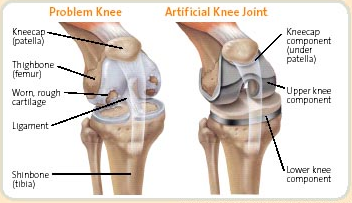Stem Cell Knee vs Total Knee Replacement for Knee Pain 2023
Sitting, standing, walking, driving—those with knee pain know how much harder it
can make doing the things we need to do every day. Traditional joint replacement
can make a real difference, as can regenerative procedures, such as stem cell
therapy, that use your own adult stem cells to naturally repair damage. Knee
pain is debilitating and often tough to manage on your own, but navigating all
of the potential treatment options can leave patients confused and wondering
which option is right for them. In particular, patients struggle to decide
between joint replacement and regenerative options, such as stem cell therapy,
to manage their pain.
Read on to see if stem cell therapy or joint replacement is the right treatment for your knee pain.


|
| The stages of osteoarthritis, as demonstrated in the knee joint |
Read on to see if stem cell therapy or joint replacement is the right treatment for your knee pain.
Procedure
While stem cell therapy and knee replacement surgery are both straightforward procedures from an orthopedic standpoint, knee replacement surgery has a higher success rate at the cost of being significantly more invasive. Stem cell therapy is regenerative, meaning that it helps your body rebuild the damage in your knees naturally using your own adult stem cells. Because some people’s bodies react differently to stem cell therapy, the success of the procedure, in terms of pain alleviation, will vary by patient. To learn more about stem cell therapy, visit Dr. Carlson’s page, Using Adult Stem Cells For The Treatment Of Pain, then check out the video below the Mayo Clinic explaining the procedure:Recovery Time
Perhaps one of the most significant differences between stem cell therapy and knee replacement surgery is the amount of recovery time required of each procedure. Because a knee replacement is such a significant surgery, the recovery time can take months. One of the major advantages of stem cell therapy is that patients generally see a much smaller reduction in their mobility as a result of the procedure. This translates to a shorter recovery period and significantly more freedom for patients following therapy sessions when compared to patients who undergo joint replacement surgeries.Cost of Stem Cell Therapy For Knees
Some quotes for stem cell knee treatment are as low as $5,000. Others cost up to $20,000 or more. Again, this depends on how many treatments a patient needs, as well as how many joints they’re treating at the same time. Because it’s easier to “batch prepare” stem cells, a patient treating more than one knee (or another joint) can address multiple sites for far less. The procedure might only cost an addition of about $2,000 or so per joint.
Related: Cost of stem cell therapy for knees
Insurance
Despite the fact that medical practitioners have used stem cells for
decades in the treatment of various diseases, their use as a treatment
for pain is relatively new. Due to the cutting-edge nature of
regenerative medicine, many insurance companies do not yet cover stem
cell therapy as a treatment for pain. However, Medicare and private
insurance do generally cover the majority of the costs associated with
knee replacement surgery as a method of pain management. The cost of
stem cell treatment varies based on which procedure is performed.
Total Knee Replacement vs Stem Cell Therapy for Knee Pain
There is no one size fits all treatment. There are many options
available. On one side of the spectrum are non-invasive strategies
such as losing weight and appropriate physical therapy to strengthen
your muscles and to have proper walking, standing and sitting
habits. In the middle you will have less invasive strategies such as
injectables i.e. PRP, steroids, stem cells etc. On the other end of
the spectrum are invasive surgical treatments such as bone
realignment surgery and total knee replacement (TKR).

PRP might be suitable for stage 1 and 2 knee osteoarthritis and stem
cells for stage 2 and 3. Total knee replacement surgery might be
suitable for Stage 4 knee osteoarthritis.
Discuss with your doctor and choose the least invasive method to
begin with.

.png)
.png)






Comments
Post a Comment